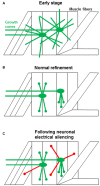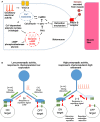Activity-Dependent Synaptic Refinement: New Insights from Drosophila
- PMID: 28484377
- PMCID: PMC5399093
- DOI: 10.3389/fnsys.2017.00023
Activity-Dependent Synaptic Refinement: New Insights from Drosophila
Abstract
During development, neurons establish inappropriate connections as they seek out their synaptic partners, resulting in supernumerary synapses that must be pruned away. The removal of miswired synapses usually involves electrical activity, often through a Hebbian spike-timing mechanism. A novel form of activity-dependent refinement is used by Drosophila that may be non-Hebbian, and is critical for generating the precise connectivity observed in that system. In Drosophila, motoneurons use both glutamate and the biogenic amine octopamine for neurotransmission, and the muscle fibers receive multiple synaptic inputs. Motoneuron growth cones respond in a time-regulated fashion to multiple chemotropic signals arising from their postsynaptic partners. Central to this mechanism is a very low frequency (<0.03 Hz) oscillation of presynaptic cytoplasmic calcium, that regulates and coordinates the action of multiple downstream effectors involved in the withdrawal from off-target contacts. Low frequency calcium oscillations are widely observed in developing neural circuits in mammals, and have been shown to be critical for normal connectivity in a variety of neural systems. In Drosophila these mechanisms allow the growth cone to sample widely among possible synaptic partners, evaluate opponent chemotropic signals, and withdraw from off-target contacts. It is possible that the underlying molecular mechanisms are conserved widely among invertebrates and vertebrates.
Keywords: chemorepulsion; neuromuscular junction; non-Hebbian; oscillation; second messengers.
Figures


Similar articles
-
In Vivo Calcium Signaling during Synaptic Refinement at the Drosophila Neuromuscular Junction.J Neurosci. 2017 May 31;37(22):5511-5526. doi: 10.1523/JNEUROSCI.2922-16.2017. Epub 2017 May 5. J Neurosci. 2017. PMID: 28476946 Free PMC article.
-
Cyclic nucleotide signaling is required during synaptic refinement at the Drosophila neuromuscular junction.Dev Neurobiol. 2017 Jan;77(1):39-60. doi: 10.1002/dneu.22407. Epub 2016 Jun 20. Dev Neurobiol. 2017. PMID: 27281494 Free PMC article.
-
Cellular mechanisms governing synaptic development in Drosophila melanogaster.J Neurobiol. 1993 Jun;24(6):757-87. doi: 10.1002/neu.480240606. J Neurobiol. 1993. PMID: 8251016
-
Precision and plasticity during Drosophila neuromuscular development.FASEB J. 1994 Jul;8(10):731-7. doi: 10.1096/fasebj.8.10.8050672. FASEB J. 1994. PMID: 8050672 Review.
-
Nitric oxide and synaptic dynamics in the adult brain: physiopathological aspects.Rev Neurosci. 2006;17(3):309-57. doi: 10.1515/revneuro.2006.17.3.309. Rev Neurosci. 2006. PMID: 16878402 Review.
Cited by
-
In Vivo Calcium Signaling during Synaptic Refinement at the Drosophila Neuromuscular Junction.J Neurosci. 2017 May 31;37(22):5511-5526. doi: 10.1523/JNEUROSCI.2922-16.2017. Epub 2017 May 5. J Neurosci. 2017. PMID: 28476946 Free PMC article.
-
γ-secretase promotes Drosophila postsynaptic development through the cleavage of a Wnt receptor.Dev Cell. 2022 Jul 11;57(13):1643-1660.e7. doi: 10.1016/j.devcel.2022.05.006. Epub 2022 Jun 1. Dev Cell. 2022. PMID: 35654038 Free PMC article.
-
Nutraceutical and Probiotic Approaches to Examine Molecular Interactions of the Amyloid Precursor Protein APP in Drosophila Models of Alzheimer's Disease.Int J Mol Sci. 2021 Jun 29;22(13):7022. doi: 10.3390/ijms22137022. Int J Mol Sci. 2021. PMID: 34209883 Free PMC article. Review.
-
Visual Experience-Dependent Expression of Fn14 Is Required for Retinogeniculate Refinement.Neuron. 2018 Aug 8;99(3):525-539.e10. doi: 10.1016/j.neuron.2018.06.036. Epub 2018 Jul 19. Neuron. 2018. PMID: 30033152 Free PMC article.
-
The interplay between electrical and chemical synaptogenesis.J Neurophysiol. 2018 Oct 1;120(4):1914-1922. doi: 10.1152/jn.00398.2018. Epub 2018 Aug 1. J Neurophysiol. 2018. PMID: 30067121 Free PMC article. Review.
References
Publication types
Grants and funding
LinkOut - more resources
Full Text Sources
Other Literature Sources
Molecular Biology Databases

